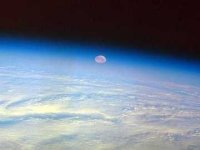|

A
Closer Look At
Pollution

OBJECTIVES
-
The student understands that human activity affects the environment.
-
The
student knows that people use scientific processes including hypothesis,
making inferences, and recording and communicating data when exploring the
natural world.
-
The student uses the scientific processes and habits of mind to solve
problems.
-
The
student recognizes
how the communities have changed over time.
-
The
student displays information by generating, collecting,
organizing, and analyzing data using simple graphs and charts.
DURATION
Two
one- hour
periods
MATERIALS
FOR Activity #3 (scroll down page)
a glass, tap water, red or blue food
coloring, a knife (get your parents or teacher to help you use
the knife), a
stick of fresh celery with the leaves still on it
Book: Berenstein
Bears Don't Pollute Anymore by Stan & Jan
Berenstein.
VOCABULARY
acid
rain, emissions, fumes, landfill, oil spill, oxygen, pesticides, pollutant,
smog, toxic waste, EPA
Glossary from
A-Z about the environment. It can be used for all lessons.
PROCEDURE
1.
Discuss what all living things need to function properly in an ecosystem: air, food,
shelter.
Ask the question "What happens when these things are damaged or there
is none available?"
2.
Read the story The Berenstein Bears Don't Pollute (Anymore) by Stan & Jan
Berenstein
3.
Discuss the problem in Bear Country.
PROBLEM: There was too much pollution in Bear Country.
4.
Discuss the causes and effects of pollution in Bear Country.
Chemicals
from companies caused the air to be dirty. Papa Bear and the Wood bears Plant were cutting trees and squirrels had no nuts to eat. The
land and streams were full of trash hurting the animals. A garage was
dumping oil into the streams killing the fish.
5. Discuss that the same factors affecting Bear Country are affecting our
Earth's ecosystems.
6.
The student will visit the following websites and other resources to collect information on Air
Pollution, Land Pollution and Water
Pollution: It's causes and effects.
a. American Lung
Association Talk about pollution
b. The
Kids Ecology Corps air pollution, water pollution, waste
c. FactMonster
click on science, then environment, then MajorAir Pollutants
7.
The student will write a two column note to explain the causes and effects of all
types of pollution. Then the student will create a table that explains and
illustrates the causes and effects of air, land, and water
pollution.
8. Activity
#3 Experiment
on water pollution.
EXTENSIONS
1.
Students will
search this site everyday for one week. They will record the AQI daily for
their city. At the end of the week, they will gather their data and
do a line graph to show the results This is a good site for asthmatics or
people with allergies.
AIRNOW
click with your mouse on Where
I Live. Look at the chart with a list of cities. Look for
the AQI for your city
and you will see if the air in your city today is clean or not. If your
city is not on the list you may do any city in your state.
2.
Visit EPA Superfund
Kids and read the story of When Greenville Turned Brown and how EPA (Environmental Protection
Agency) helped to make it green again. The student will then compare and
contrast Greenville with Bear Country.
HOME LEARNING
Go
on a pollution walk around your community with your parents. Write down
your observations on air pollution, land pollution and water pollution.
Write a paragraph to tell what kind of pollution you found in your neighborhood
and what you can do to help.
ASSESSMENT
1.
The student will create a table reflecting the causes
and effects of different types of pollution.
2.
The student will use the scientific method to experiment with water pollution and write each step.
3. The student will write to explain a
comparison between Bear Country and Greenville.
|